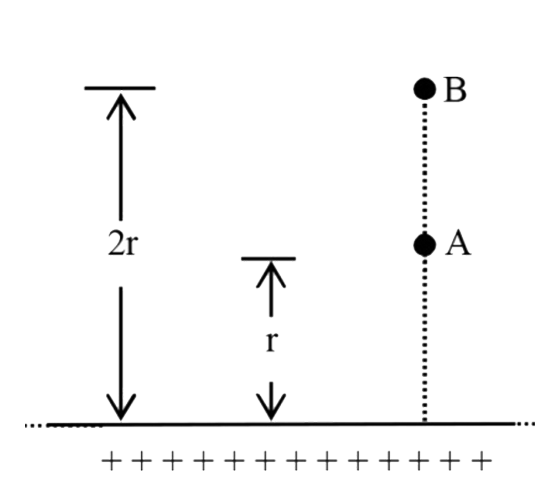An infinite thread of charge density λ lies along z-axis. The potential difference between points A(4,3,4) and (3,4,0) is

λ2π∈0In(√415)
λ2π∈0In(5)
zero
λ2π∈0
The correct Answer is:C
Equipotential surfaces are coaxial cylinders, therefore (4,3,4) and (3,4,0) lie on equipotential surface.
Topper's Solved these Questions
- TEST PAPERSBook:FIITJEEChapter:TEST PAPERSExercise:PHYSICS
Explore 747 Videos
- SIMPLE HARMONIC MOTIONBook:FIITJEEChapter:SIMPLE HARMONIC MOTIONExercise:Assignment Problems (Objective) (Level-II)
Explore 20 Videos
- WORK, ENERGY AND POWER Book:FIITJEEChapter:WORK, ENERGY AND POWER Exercise:COMPREHENSIONS ( Comprehension-II)
Explore 5 Videos
Similar Questions
An infinitely long line of linear charge density λ is shown in the figure. The potential difference VA−VB between the two points A and B is

View SolutionA uniform electric field is along x-axis. The potential difference VA−VB=10V is between two points A (2m, 3m) and (4m, 8m). Find the electric field intensity.
View Solution
Knowledge Check
The point (-2, 3, 4) lies in
AI octantBVI octantCII octantDV octantFor an infinite line of charge having linear charge density λ lying along x-axis the work done in moving a charge q form C to A along CA is
 Aqλ2πε0In2Bqλ2πε0In√2Cqλ4πε0In2Dqλ2πε0In(0.5)
Aqλ2πε0In2Bqλ2πε0In√2Cqλ4πε0In2Dqλ2πε0In(0.5)The pair of rational numbers that lies between 14 and 34 is
A2621000,7521000B24100,74100C940,3140D2521000,7481000
There is an infinitely long straight thread carrying a charge with linear density λ=0.40μC/m. Calculate the potentail difference between points I and 2 is removed η=2.0 times farhter from the thread than point 1.
View SolutionThere is infinitely long straight thread carrying a charge with linear density λ.Calculate the potential difference A and B.

View SolutionAn infinite conducting sheet has surface charge density σ. The distance between two points is r. The potential difference (VA−VB) between these point is

View SolutionThere is a uniformly charged ring having radius R. An infinite line charge (charge per unit length lambda) is placed along a diameter of the ring (in gravity free space). Total charge on the ring Q=4√2λR. An electron of mass m is released from rest on the axis of the ring at a distance x=√3R from the centre.

Potential difference between points A(x=√3R) and B(x=R)i.e.(VA−VB) is
View SolutionOne long conductor carries current I along y-axis with charge density λ. An electric field exists along z-axis. In what direction, a charged particle at point P, distance x apart from the wire (along x-axis), be projected with velocity v so that it moves undeflected?

View Solution

